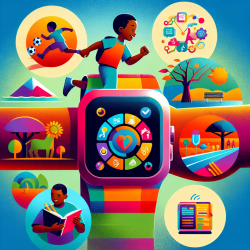Revolutionizing Child Development with Wearable Technology
In the ever-evolving field of child development, innovative approaches are crucial for gaining deeper insights into the growth and health of young children. A recent study titled Combining Wearable Devices and Mobile Surveys to Study Child and Youth Development in Malawi: Implementation Study of a Multimodal Approach sheds light on how wearable technology can be leveraged to enhance our understanding of child development, particularly in resource-constrained settings like Malawi.
The Power of Multimodal Approaches
The study conducted in Malawi utilized a multimodal approach combining wearable devices, mobile surveys, and face-to-face interviews. This method allowed researchers to collect high-frequency data on children's health and development from multiple perspectives. By integrating noninvasive biomarkers, social contact patterns, and mobile surveying, the study aimed to validate technologies that could provide a comprehensive view of child development.
Key Findings and Their Implications
The study revealed several promising outcomes:
- High-Frequency Data Collection: The use of wearable devices such as EEG headbands and ECG pads enabled the collection of reliable data on children's cognitive and physical health at a high frequency.
- Social Contact Patterns: Wearable proximity sensors provided insights into social interactions, which are crucial for understanding disease transmission and social development.
- Mobile Surveys: Interactive voice response (IVR) calls allowed for the collection of self-reported data on symptoms, nutrition, and early stimulation, offering a broader understanding of the children's environment.
These findings suggest that multimodal approaches can significantly enhance our ability to monitor and understand child development, even in low-resource settings. By integrating various data streams, practitioners can gain a holistic view of a child's health and development, enabling more targeted interventions.
Practical Applications for Practitioners
For practitioners looking to improve their skills and methodologies, the study offers several practical applications:
- Adopt Multimodal Approaches: Integrating wearable technology with traditional methods can provide a more comprehensive understanding of child development.
- Focus on High-Frequency Data: Regular data collection can help identify critical inflection points and interactions between different conditions and behaviors.
- Utilize Mobile Surveys: Leveraging mobile technology for data collection can be a cost-effective way to gather information in resource-limited settings.
By incorporating these strategies, practitioners can enhance their ability to monitor child development and implement more effective interventions.
Encouraging Further Research
While the study provides valuable insights, it also highlights the need for further research to explore the full potential of multimodal approaches in child development. Practitioners are encouraged to engage in additional studies to validate and expand upon these findings, particularly in different cultural and geographical contexts.
To read the original research paper, please follow this link: Combining Wearable Devices and Mobile Surveys to Study Child and Youth Development in Malawi: Implementation Study of a Multimodal Approach.










